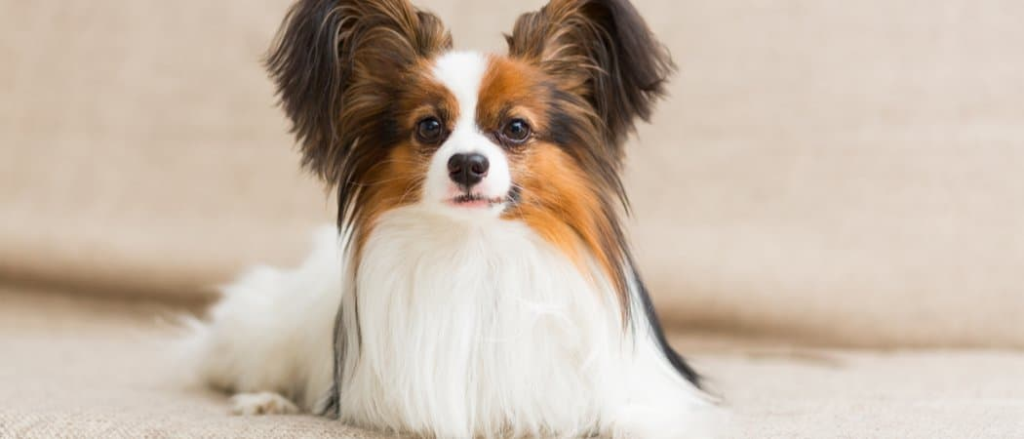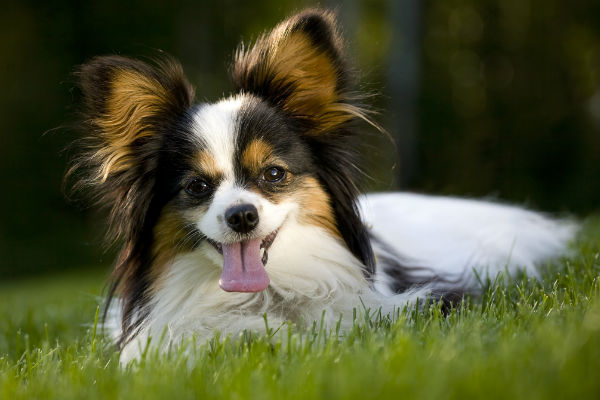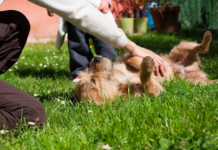Last Updated on December 10, 2023 by Fumipets
The Papillon, a small and elegant dog breed, is renowned for its distinctive butterfly-like ears and graceful appearance. Originating from Europe, specifically France and Belgium, these toy dogs have gained popularity for their charming demeanor and intelligence. Despite their delicate appearance, Papillons are known for their agility and can excel in various activities. Here’s a brief overview of this captivating dog breed.
Papillon Dog Breed
| Height: | 8 – 11 inches |
| Weight: | 5 – 10 pounds |
| Lifespan: | 14 – 16 years |
| Colors: | White and black, white and lemon, white and red, white and sable, white black and tan |
| Suitable for: | Families with children, first-time owners, apartments |
| Temperament: | Affectionate, companions, confident, intelligent, eager to please |
The stunning Papillon dog breed is distinguished by its ears that resemble butterflies. But this dog is more than just a pretty face. For ages, these affectionate toy breed dogs have been the ideal companions, winning the hearts of many people.
The origins of these dogs are still unknown, despite their widespread appeal. All that is known about these perceptive and amusing canines is that they have long been a fan favorite and have even been preserved in the works of renowned painters.
If you’re thinking of getting a Papillon, be sure to read this guide to find out more about its special characteristics and the reasons why so many people have fallen in love with them over the years.
3 Little-Known Facts About Papillons
Not only the is the Papillon’s ears amazing about these canines. They are a fascinating dog breed overall due to their distinctive personalities and characteristics.
1. When it comes to obedience events, Papillons top the list of toy breeds for best performance.
Highly bright dogs, papillons are eager to please their owners. They are also incredibly self-assured and often overlook their little stature. Papillons often go headlong into a challenge or novel scenario without any hesitancy, in contrast to other toy dog breeds. Their DNA does not inherently include timidity.
The Papillon is a top choice for agility and obedience training contests because to this mix of characteristics. They pick things up fast and often react well to compliments and rewards. In reality, the Westminster Kennel Club’s agility competition in 2019 saw a Papillon called Gabby place first in her class.
2. French Queen and icon, Marie Antoinette, owned a Papillon named Coco.
While she was the Queen of France, Marie Antoinette had numerous dogs as pets, but Coco the Papillon was her favorite. Coco lived longer than Marie Antoinette and made it through the French Revolution. This dog also survived Napoleon’s defeat and the whole Napoleonic period.
The dog’s ultimate burial place is in the grounds of the Hôtel de Seignelay. Coco enjoyed a long life of 22 years. In close proximity to the location of Marie Antoinette’s beheading, visitors to the Hôtel de Seignelay are welcome to see the tombstone of this dog.
3. Since the late 15th century, papillons have been shown in several paintings and portraits.
Paintings of the Papillon were popular with both dog owners and artists. The Papillon was shown in religious scene paintings in addition to family portraits. Numerous well-known artists, including Titian, Goya, and Rembrandt, have depicted these dogs.

Temperament & Intelligence of the Papillon
There’s a good reason why the Papillon is so beloved. This dog breed gets along with just about everyone and any pet and has a good disposition. They like being among others and are cheerful and vivacious. They make excellent pupils of obedience since they are also quite clever and eager to please.
These little canines can live well in flats. However, they often speak up. As a result, if your apartment complex has stringent noise regulations, be ready to put some effort into teaching your dog not to bark.
Are These Dogs Good for Families?
Papillons are companion dogs, thus they will like to live with families. They will function best in homes where at least one person is always present. These canines dislike being alone and get anxious and melancholy if left at home alone for an extended period of time.
The Papillon is no different from other dogs in that they gain a lot from early socialization. Papillons often get along well with kids. Since they’re so little, it’s unlikely that they’ll play rough with younger kids in a way that may harm them.
These dogs, however, are exceedingly energetic, particularly as pups. As a result, constantly keep an eye on kids and Papillons while they are playing and interacting. Young toddlers may unintentionally trip as they attempt to follow an active Papillon zipping around a room.
Does This Breed Get Along with Other Pets?
Papillons like to be around people. They get along with other dogs and household pets, however, since they are friendly dogs. Early socialization will significantly boost the probability that Papillons will successfully coexist with other pets, just as it does for young children.
To keep Papillon pups from being overstimulated or anxious, expose them to other animals gradually. Due to their tiny size, Papillons are vulnerable to being demolished by bigger dogs. A few members of this breed may have a high prey drive since they have a spaniel heritage. As a result, Papillon pups shouldn’t be left alone until they have developed a link with the other animals.
Things to Know When Owning a Papillon:
Knowing how to best care for a Papillon will let you see how happy and playful it can be. Compared to other purebred dog breeds, papillons are very healthy and low-maintenance, but they still have breed-specific requirements that call for their owners’ vigilance.
Food & Diet Requirements
A meal rich in protein will be beneficial for papillons because of their high level of energy. The possibility of papillons accidently consuming chicken is reduced by feeding them limited-ingredient dog food since they might also have a chicken allergy. If you wish to give your Papillon dog food, be sure to choose a formula designed for toy breeds with smaller kibble sizes.
A Papillon has to be fed appropriately since this dog breed is prone to obesity. Papillons may consume between 14 cup and 12 cup of food per day, depending on how much activity they get each day. Foods with a lot of carbohydrates should be avoided since they make it simpler for Papillons to acquire weight.
The ideal diet for your Papillon may be developed in collaboration with your veterinarian.
Exercise
The Papillon has a lot more energy than other toy dog breeds. They’ll function best if they exercise for at least 40 minutes each day. Daily strolls that allow them to explore the area and sate their curiosity will be beneficial to them. These dogs like playing catch and letting go by running about a fenced yard since they are very swift.
Training
The Papillon has a lot more energy than other toy dog breeds. They’ll function best if they exercise for at least 40 minutes each day. Daily strolls that allow them to explore the area and sate their curiosity will be beneficial to them. These dogs like playing catch and letting go by running about a fenced yard since they are very swift.
Papillons are excellent for novice dog owners since they are simple to train and eager to please. Despite their excellent trainability, owners shouldn’t skip out on training. The development of a strong foundation in fundamental obedience training will be beneficial for papillons. These dogs are eager learners by nature, so training them may be a wonderful opportunity for owners to strengthen their relationship with them.
Papillons are fast to pick up new skills after they have completed their basic obedience training. These dogs need cerebral exercise, therefore puzzle toys and toys that release treats may be their favorite activities. Additionally, this breed is a strong contender for agility and obedience contests.

Grooming
The long, smooth coat of papillons needs little maintenance. Although the coat doesn’t tangle readily, it sheds very little. So it’s advisable to use a steel comb and slicker brush to brush the coat at least once every week.
You might try using a deshedding tool if your Papillon has shedding problems. If the Papillon’s coat seems dry and lifeless, you may experiment with feeding the dog skin and coat supplements to see if this reduces the quantity of shedding.
The lack of strong natural scents in papillons means that they don’t need to take as many baths. A Papillon should only need a monthly bath if they stay clean. Baths should not be taken often since they might dry up the skin. Because certain Papillons are prone to atopy, while bathing a Papillon, be careful to use a mild shampoo.
Health and Conditions
The purebred Papillon dog has a good level of health. Later in their lives, the majority of these dogs may have minor health issues. Since these ailments are often curable, Papillons may adjust and continue living without suffering much from them.
But if left untreated, several of these ailments may seriously harm a Papillon’s health. As a result, stay consistent with your yearly trips to the doctor so that you can routinely check on a Papillon’s health.
Minor Conditions
Patellar luxation
Progressive retinal atrophy (PRA)
Food allergies
Atopy
Von Willebrand’s Disease (VWD)
Serious Conditions
Seizures
Intervertebral disk disease (IVDD)
Male vs Female
The widely held belief that male Papillons make better friends than female Papillon canines is unsupported by scientific evidence. Male Papillons are more relational and need human contact, according to many Papillon owners. They may sometimes be excessively clingy for dog owners.
Female Papillons, on the other hand, tend to be more autonomous and self-assured. They may be a bit more aloof, however, so they could be a little harder to teach at first.
The size of male and female Papillons also differs. Males often measure a few inches larger than females.
In general, every Papillon is distinct. Therefore, rather of depending exclusively on their sex, it is preferable to get to know each person’s unique characteristics and family history.
Conclusion
Papillons are companion-loving, family-oriented canines. They’re excellent for new dog owners since they’re smart, need little maintenance, and have genetics that is generally in good shape.
It’s hardly surprising that these kind and affectionate dogs have been so well-liked for such a long time given what we know about them. With their humorous characteristics, these dogs have made many people happy, and we have no doubt that they will remain a popular dog breed for a very long time.


















